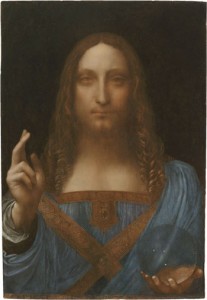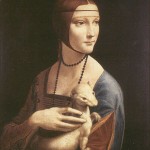 Short of a time machine, there’s just no way to authenticate some works of art. The above painting, Salvator Mundi or Savior of the World, is widely believed to have been painted by Leonardo DaVinci in the late 1490s or early 1500s. “Widely believed” is about as close as we’ll ever come to knowing for sure.
Short of a time machine, there’s just no way to authenticate some works of art. The above painting, Salvator Mundi or Savior of the World, is widely believed to have been painted by Leonardo DaVinci in the late 1490s or early 1500s. “Widely believed” is about as close as we’ll ever come to knowing for sure.
Why? It’s not just the lack of signature–signatures are in fact one of the least dependable methods of authentication (the practice of signing art began only about a century before DaVinci; forgers began copying signatures almost immediately). Salvator Mundi was unsigned, heavily overpainted, and sloppily conserved numerous times over the centuries. It languished in several museums and private collections (including that of to-be-beheaded King Charlies I of England) and was lost several times. It was only after a painstaking cleaning in 2009 that the underlying paint was revealed in its entirety. After more than a year of scholarly examination and debate, Salvator Mundi was identified, as definitively as possible, as a DaVinci original.
 Another DaVinci painting, now recognized as one of his most iconic, underwent similar rediscovery in the last century. The Lady with an Ermine, a portrait of Cecilia Gallerani (mistress of the Duke of Milan), had long been described as a celebrated part of DaVinci’s catalog, and one of only four female portraits he’s known to have completed. It was “lost” sometime before 1877, and was finally rediscovered in 1945 among a Nazi hoard. Subsequent authentication took years – despite Leonardo’s name being etched in the upper-left corner. Lady with an Ermine is now almost universally accepted as DaVinci’s work, although the signature is nearly certain to have been added much later by another hand.
Another DaVinci painting, now recognized as one of his most iconic, underwent similar rediscovery in the last century. The Lady with an Ermine, a portrait of Cecilia Gallerani (mistress of the Duke of Milan), had long been described as a celebrated part of DaVinci’s catalog, and one of only four female portraits he’s known to have completed. It was “lost” sometime before 1877, and was finally rediscovered in 1945 among a Nazi hoard. Subsequent authentication took years – despite Leonardo’s name being etched in the upper-left corner. Lady with an Ermine is now almost universally accepted as DaVinci’s work, although the signature is nearly certain to have been added much later by another hand.
So it goes with art. When it comes to the most culturally significant masters, we’ll always have forged signatures and questionable provenance. But just as Salvator Mundi shows, we’ll also have occasional new additions to collections we’d assumed complete. Even if we can never be one hundred percent sure of authenticity, it’s still enough to keep the art world alive and exciting.